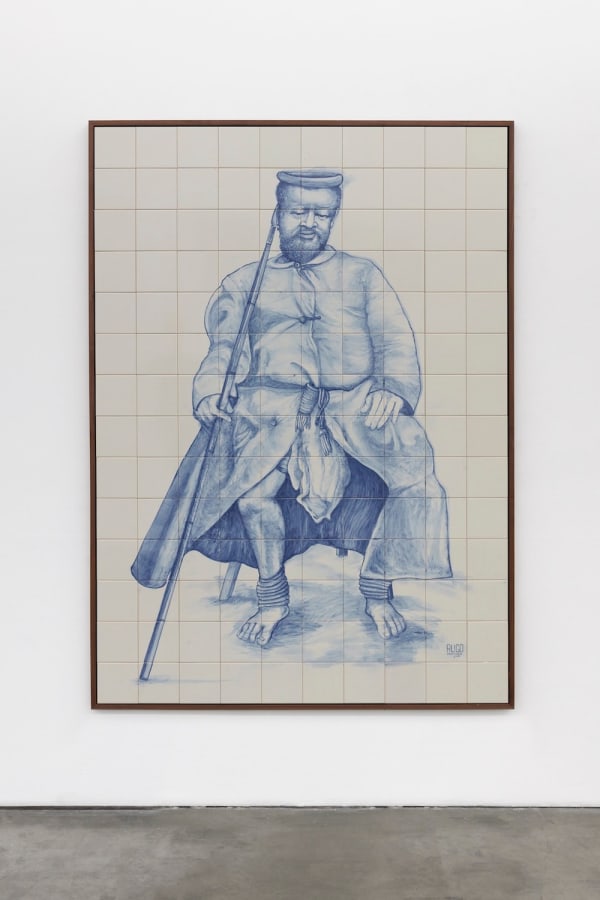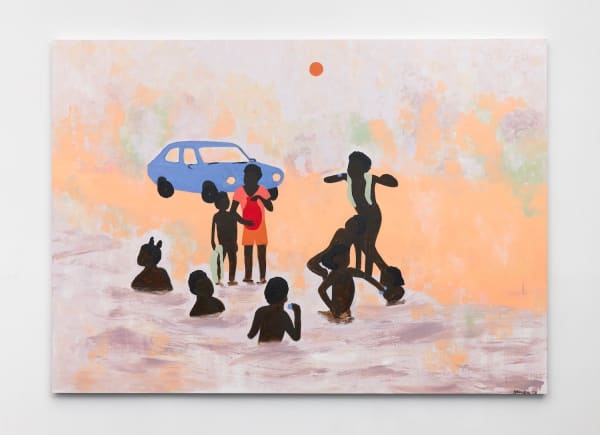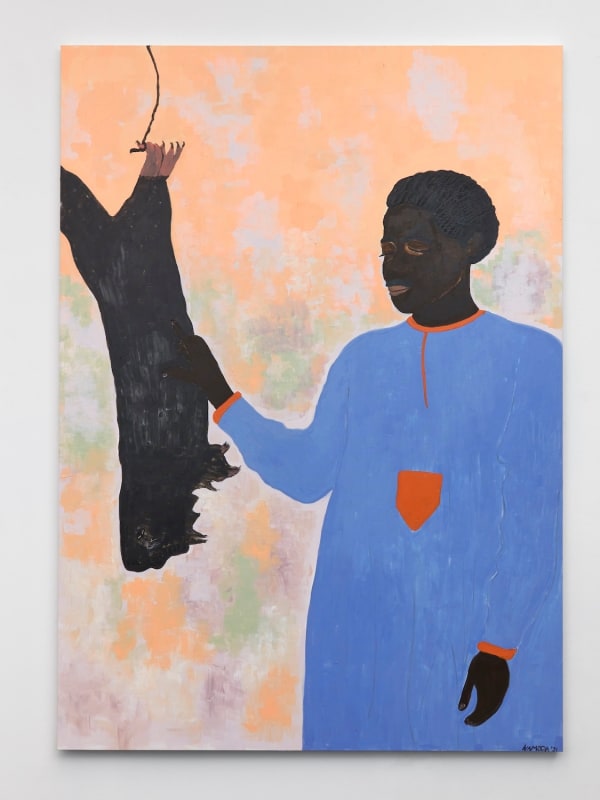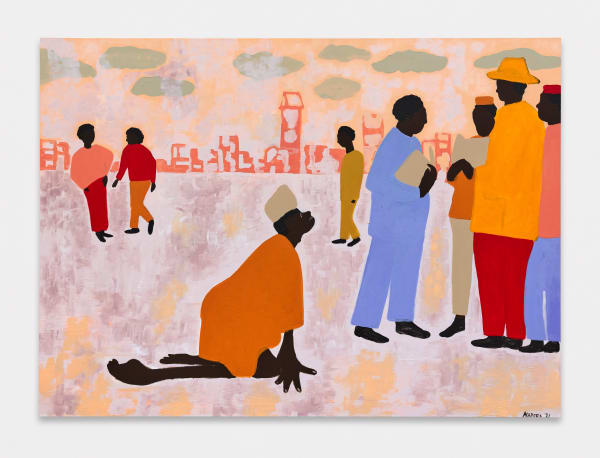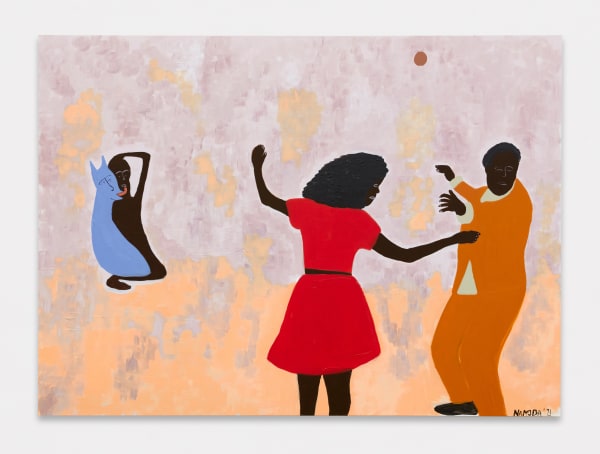Cassi Namoda: Forgotten Limbs
François Ghebaly is proud to present Cassi Namoda’s third solo-exhibition with the gallery titled Forgotten Limbs. The exhibition addresses questions that are central to Namoda’s practice, primarily the question of how to render war and colonization through visual metaphor, in a particularly Luso-African context.
Forgotten Limbs speaks to the collective feeling of disembodiment and alienation experienced by Africans living in post-colonial nations generally, but it specifically locates itself in Mozambique, incorporating photographs, landscapes, music and vernacular from the nation’s culture. The paintings and works on tile use the exile of Gungunhana, the last dynastic emperor of Gaza (present day Mozambique), as a point of entry to thematically explore the aftermaths of war and the privation of resources in times of conflict. Forgotten Limbs is Namoda’s largest body of work to-date and its penchant for allusion and reframing of archival footage, as well as its fluid use of various media, brings to fruition the research-based, multimedia practice that guides Namoda’s work. The media and materials that comprise this series symbolically mirror the cities her works draw their vitality from: the concrete blocks and African mahogany panels that make up the structures throughout the exhibition are the same building materials that are used to construct African cities today. Similarly, the blue and white works on ceramic tile that open the exhibition appropriate the style of azulejos, Portuguese and Spanish decorative tile-works whose images often convey a historical or cultural narrative. In Forgotten Limbs, the narrative foregrounded on the tiles is one of exile and cultural dislocation, as opposed to the religious or simply ornamental scenes traditionally depicted in azulejos in the Lusophone world. There is an awareness in the works in this exhibition of being a product of a hybrid, Luso-african culture, so that when one is in Mozambique they see that it is not a site of purely African thought or aesthetics but carries the accrual of colonial influence and is constantly negotiating that influence.
In the paintings that appear in the first three rooms of the exhibition, Namoda transfigures these historical tensions into images of surreality. The tones of pale lilac, pale green and peach that these works gravitate towards are illusory and dreamlike, creating a stark contrast against the viscerality of the subjects that populate them. It is as though the colors chosen for the figures in the foreground of these paintings positions them in reality while the backdrops they occupy veer into the magical or fantastical. The paintings oscillate between scenes of ecstasy and tragedy and like the Swahili folklore that they draw upon, they are animated by states of heightened emotion. In the painting Sleepwalking Land, which lifts its title from Mia Couto’s novel of the same name, a poor man is ignored by a small crowd while he begs in a dilapidated cityscape which represents a community estranged from itself by capitalism. Beside this painting hangs An ecstatic vision at Bar Mundo, which depicts a dancing couple in high spirits, looking on at a vision of Satan intertwined with a Makonde man. This painting signals the merging of the symbolic and religious into the realism of both city and rural life. Overall, there is a sense that Mozambican vernacular landscapes are charged with life and with a spiritual essence. This animistic view of place colors the narrative cultivated through the paintings in Forgotten Limbs.
There is a writerly quality to the works in the exhibition that comes through the titling of the paintings and tile-works as well as through the richness of their content. With titles including We delight in earthly offerings, a good rain shower has arrived in Quelimane today or Bar Texas, 1972, viewers are brought into contact with the surface of what proves to be multi-layered, poetic and place specific body of work. Namoda’s narration throughout Forgotten Limbs is at once unpredictable and organic. The works in this exhibition extend the lifespan of motifs that crop up in earlier paintings by Namoda, including the oft recurring Maria, a composite image of African women navigating the sexual and political terrain of life in postcolonial Mozambique, and the pair of conjoined twins, whose atypicality calls into question the norms we cling to and what we make of those who fall outside of them. In the final room of the exhibition, the dancing couple that appears elsewhere, in painting, is reiterated in a video of an Angolan couple closely dancing tarrachinha on a bustling shore — the sensuality of the symbol is brought to life. Namoda’s ability to synthesize and reframe her literary, cinematic and cultural influences, as well as her skill in creating new images and new arrangements makes for a body of work that is revisitable for all of its equivocal sources and meanings.
Text by Stephanie Njeri Wambugu
Cassi Namoda (b. 1988, Maputo, Mozambique) is a painter whose work deftly captures the vibrancy and nuance of post-colonial Mozambique in an increasingly globalized world. Her work is held in the public collections of the Studio Museum in Harlem; Baltimore Museum of Art; Inhotim Institute, Brazil; K11 Art Foundation, Hong Kong; and Pérez Art Museum Miami. Recent solo exhibitions include Mendes Wood DM, São Paulo; Goodman Gallery, Johannesburg; Pippi Houldsworth, London; and François Ghebaly, Los Angeles. Namoda’s work has been included in exhibitions at Caribbean Cultural Center African Diaspora Institute, New York; Museum of Contemporary African Diasporan Arts, New York; CFHILL, Stockholm; and Library Street Collective, Detroit. She lives and works in New York.
-
 Cassi Namoda, The favorite of Gungunhana, 2021
Cassi Namoda, The favorite of Gungunhana, 2021 -
 Cassi Namoda, The great defeat of Gungunhana, 2021
Cassi Namoda, The great defeat of Gungunhana, 2021 -
 Cassi Namoda, A portrait of Gungunhana, 2021
Cassi Namoda, A portrait of Gungunhana, 2021 -
 Cassi Namoda, Exile on Terceira, 2021
Cassi Namoda, Exile on Terceira, 2021 -
 Cassi Namoda, A wounded Cuban soldier at the border of Cabinda province, 2021
Cassi Namoda, A wounded Cuban soldier at the border of Cabinda province, 2021 -
 Cassi Namoda, Meat is meat, 2021
Cassi Namoda, Meat is meat, 2021 -
 Cassi Namoda, A Holy Spirit of conviction, 2021
Cassi Namoda, A Holy Spirit of conviction, 2021 -
 Cassi Namoda, Hackneyed limbs at communal rest somewhere in Baixa, 2021
Cassi Namoda, Hackneyed limbs at communal rest somewhere in Baixa, 2021 -
 Cassi Namoda, Bar Texas, 1972, 2021
Cassi Namoda, Bar Texas, 1972, 2021 -
 Cassi Namoda, Alas, a beautiful Maria lost in a vision, 2021
Cassi Namoda, Alas, a beautiful Maria lost in a vision, 2021 -
 Cassi Namoda, We were born twins in Maputo, Mozambique October 22nd 1988 to Ivette Maria da Conceição, an ode, 2021
Cassi Namoda, We were born twins in Maputo, Mozambique October 22nd 1988 to Ivette Maria da Conceição, an ode, 2021 -
 Cassi Namoda, We delight in earthly offerings, a good rain shower has arrived in Quelimane today, 2021
Cassi Namoda, We delight in earthly offerings, a good rain shower has arrived in Quelimane today, 2021 -
 Cassi Namoda, Sleepwalking Land, 2021
Cassi Namoda, Sleepwalking Land, 2021 -
 Cassi Namoda, Beautiful beast you are a feast, 2021
Cassi Namoda, Beautiful beast you are a feast, 2021 -
 Cassi Namoda, A town that aches of old memories and reeks of urine, 2021
Cassi Namoda, A town that aches of old memories and reeks of urine, 2021 -
 Cassi Namoda, Disembodied boy with balloons disembarks from Catumbela, 2021
Cassi Namoda, Disembodied boy with balloons disembarks from Catumbela, 2021 -
 Cassi Namoda, An ecstatic vision at Bar Mundo, 2021
Cassi Namoda, An ecstatic vision at Bar Mundo, 2021




